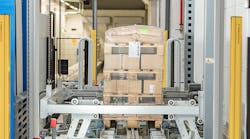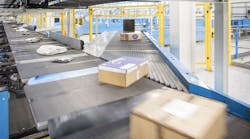Recent
From a kiln cooling system to silos: the safe and economical transportation of hot materials like clinker is crucial in cement plants. The material can have extremely high temperatures of 500 to 800°C. Reliable plant operation requires a robust conveying system. The BEUMER Group supports cement manufacturers with system solutions tailored for this industry, with apron conveyors for example. A special variant offered is the belt apron conveyor (GSZF): using a belt instead of a chain as the traction element allows higher speeds and a slimmer design while still delivering the same level of performance. The GSZF is therefore particularly suitable for modernizations, as can be seen with the Turkish cement manufacturer Göltas Cemento.
Why are apron conveyors particularly efficient for the transport of clinker? André Tissen doesn't need to think long: "The cement plant operators are still not able to ensure with one hundred percent certainty that the material does not leave the clinker cooler at temperatures of 500 to 800°C." Tissen is a sales manager for Customer Support at BEUMER Group and is familiar with the demands of the customers. In general, the clinker should cool down to the ambient temperature plus 80°, but during the process, a so-called raw meal flash can occur in the shell section of the preheater tower, caused by breaks in the kiln outlet sealing. "It doesn't happen often, but it does happen. It can't be completely avoided," explains the expert. Within a few seconds, several tons of raw meal or clinker run through the cooler. The material cannot cool down and arrives on the conveyor at extremely high temperatures. BEUMER Group apron conveyors provide robust and reliable solutions that are completely heat resistant. The specific design of the cells allows safe, low-friction transportation of any hot material. Sealed and overlapping sidewalls and bottom plates in the cells prevent the clinker from exiting and minimize the escape of dust. Operators get the BEUMER apron conveyors SZF and GSZF with cell width gradations from 500 to 2,000 mm, center distances of more than 250 m and conveying capacities of over 1,300 m³ per hour.
Angles of inclination up to 60-deg.
The angles of inclination on the SZFs and GSZFs depend on the height of the silo and the conveying distance. The systems come in three different designs. "We have an open-cell design where the bulk material is transported at an angle of up to 30-deg. without rolling back," explains Tissen. The cells on the second design are equipped with baffle plates. Inclinations of up to 45-deg. are possible. The design as a steel box conveyor allows extreme inclinations of up to 60-deg. "This design is perfect for steep inclinations and small curves, but also smaller inclinations when transporting clinker with a high content of fine particles," he describes.
And this is becoming more and more important for operators. Instead of using fossil fuels like coal and gas they are opting for alternative fuels to reduce greenhouse gas emissions and production costs. Besides liquid materials like waste oil or solvents, the majority of the solid alternative fuels are composed of municipal and industrial waste, such as plastic, paper, composite material, and textile mixes. This also changes the chemical process. "Clinker grains are spherical with a diameter of 10 to 30 mm and the content of fine particles is less than 5% when using fossil fuels. This content increases however to 30% when using alternative fuels," explains Tissen. "To handle this safely, the boxes need to be completely enclosed."
Belts - the economical alternative
The traction element in the conveyor is usually a single or double strand sprocket chain, designed as a steel-bushed roller chain with a pitch of 315 mm. Finely regraded versions for braking forces ranging between 250 and 2,700-kN ensure optimum adaptation to the required parameters. The maximum conveying speed is 0.3 m/s.
"Instead of a chain we also offer the apron conveyors with our tried and tested BEUMER steel wire belt coming from the bucket elevator technology," reports the expert. Here the cells are attached to the low-wear, long-lasting and steel-wire reinforced belt in a way so that the heat of the clinker in the steel cells is not transferred on to the belt. A special profile between the steel cells and the belt prevents this. Partition plates are attached in the material feeding area below the cooler and can be easily removed for maintenance, protecting the belt against hot clinker in case of a kiln flash.
Perfect for retrofitting
One decisive advantage of the belt apron conveyor: with 0.6 m/s, it can reach double the conveying speed compared to apron conveyors with a chain. "This makes it perfect for retrofitting and modernizations," says Tissen. If the operator wants to increase the kiln capacity for example, he can replace an existing apron conveyor with a belt version of the same size. It means double the capacity without having to change anything on the steel structure or the conveyor bridge.
The operator also benefits of a new construction application: The thinner, lighter design of the GSZF reduces costs for the steel structure and freight. Furthermore, the decreased net weight lowers the static and dynamic loads which affect the clinker silo and the foundations for example. "A new construction project can be designed for a smaller load and is, therefore, more cost-effective to build," explains the expert. "The lightweight design also lowers operational costs."
Quiet, low in maintenance, reliable
As the entire belt lies with its surface on the drive and return pulley, the unwanted polygon effect on the chain is avoided. The particularly smooth running of the machine also reduces noise emission considerably. The noise is less than half as loud as conventional SZFs with chains. This is good for the employees, the environment, and the surrounding area.
The use of the durable BEUMER steel wire belt instead of a chain lowers the maintenance costs and extends maintenance intervals. Chains can also break if preventive maintenance is not performed properly, which will lead to the conveyor collapsing. "The belt with the steel wires only ages and the rubber becomes brittle, but it would never completely break," describes Tissen. Lubrication is also not required for the belt, whereas used frequently on a chain, if for no other reason than to reduce noise levels. Grease and oil are not only a cost factor but also detrimental to the environment and the conveyor. The clinker dust gets stuck on it and settles in the chain links, which accelerates the wear and tear.
Göltas Cemento opts for GSZFs
BEUMER belt apron conveyors are in operation for nearly 150 companies. One of them is the Turkish cement manufacturer Göltas Cemento, located close to Isparta, approximately 130 km north of Antalya. In the wake of a building boom in Turkey and the growing demand for cement, the cement manufacturer opted for modernizing its kiln and increasing the performance. An increase from 250 to 400 tons per hour of the conveying technology capacity was required, for a chain apron conveyor that transports the clinker from the kiln cooling system to the silo. And for economical production, Göltas Cemento has been increasingly opting for alternative fuels over the last several years, which meant that the content of fine particles also increased continuously. The existing conveyor already transported high quantities of material, and the process had become extremely dirty. Personnel was constantly needed to perform cleaning work.
To find an efficient solution and a suitable partner on their side, Göltas Cement turned to the BEUMER Group. The two companies have been working together since 1996. The system provider has supplied two clinker transport systems and four belt bucket elevators throughout their partnership. So, the cement manufacturer was already familiar with the advantages of the BEUMER steel belt technology. The project phase began mid-2015, the contract was awarded at the beginning of 2016, followed by the installation and commissioning in the fall.
Modernizations without extensive reconstruction work
"For a more powerful chain apron conveyor, we would have needed to take down the entire system including the building structures and the concrete tunnel," says Tissen, who was responsible for this project with his team. "This wasn't necessary when opting for the belt version. It reaches double the conveying speed so that the BEUMER Group engineers could design the system for increased capacity while keeping the same width. The conveyor bridge and the self-supporting steel structure, as well as the concrete foundations, remained. Göltas Cement was able to considerably reduce costs and put the system quickly into operation. "The silo is 50 m high. To overcome an inclination of 40-deg., we installed a steel box conveyor," explains the expert. It releases almost no material to the environment, despite the higher content in fine particles, creating a cleaner work environment.
For the installation work, BEUMER Group provided the supervisor and the assembly was carried out by the client personnel. "Our collaboration went great," sums up Tissen. "The assembly only was a little trickier in the very narrow concrete tunnel, where the conveyor is located. But the installation was well-prepared. So we were still able to stick to the set schedule." Göltas Cemento and BEUMER Group are already discussing future modernization projects.












